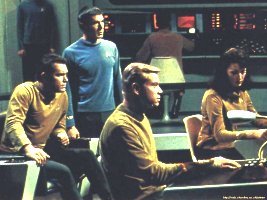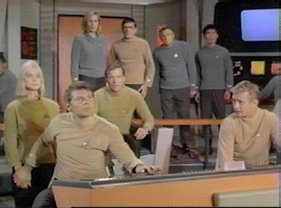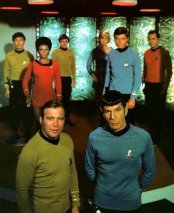

Star Trek is the show that almost wasn't. In 1964, Gene Roddenberry presented his idea for a "Wagon Train to the stars" to the CBS network, only to be rejected. NBC was interested, however, and asked for a 90-minute pilot episode, "The Cage" was filmed later that year at Desilu Studios, with the personal approval of co-owner Lucille Ball. NBC found the show to be "too cerebral" and said that it would not hold the attention of an action-orinted audience. In short, they wanted a fistfight, not a meeting of the minds. They asked Roddenberry for an unprecedented second pilot.
Many character changes took place in between "The Cage" and "Where No Man Has Gone Before", including the replacement of Captain Pike with Captain Kirk, and changing the controversially female first officer to a male. NBC approved the second pilot, and officially picked up the show in January of 1966.
"The Man Trap" aired on September 8, 1966, featuring a diverse crew which included an alien first officer, an African woman communications officer, an Asian helmsman, a Scottish engineer, and later a Russian navigator. Every character had an important job, to do, and while everyone was different, they were treated equally as an officer.
Though the show was low-budget and often laughable by today's standards, each episode presented a situation from which some lesson can be learned, if the viewer looks closely enough. The alien races introduced and conflicts presented throughout the show mirrored conditions of society that existed, do exist, and will exist somewhere in our own world. In the format of a prime-time Science Fiction television show, this helped the show address potentially sensitive issues with a lesser risk of censorship during the socially turbulent 1960's.
During the second season, NBC moved Star Trek to Friday nights at 10:00pm, causing the show to lose a large percentage of viewers. The audience was largely made up of students and children, this timeslot was too late for children, and inconvenient for students who would be out on Friday nights. A woman named Bjo Trimble organized a "Save Star Trek" campaign that helped get the show a third year, but the series came to an end on June 3, 1969, with "Turnabout Intruder".
Less than two months later, the world watched as the crew of the Apollo 11 set foot on the moon, giving the world new thought as to what we can achieve. However, in a time before syndication, and before VCRs, Star Trek faded off the air.
Enterprise Crew:
"The Cage"
|
 |
||||||||||||||||||
"Where No Man Has Gone Before"
|
 |
||||||||||||||||||
Regular Cast
|
 |
|
Episodes: [Episode Descriptions]
Pilot |
|

Cast photos from "The Cage" and of the regular cast courtesy of Star Trek in Sound and Vision
Cast photos from "Where No Man has Gone Before" courtesy of The Star Trek TOS Photo Gallery
